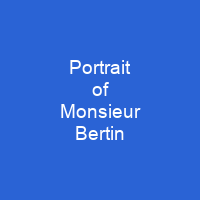Portrait of Monsieur Bertin: A Masterpiece by Jean-Auguste-Dominique Ingres
Is there a painting that encapsulates the essence of its subject like Portrait of Monsieur Bertin? This 1832 oil on canvas masterpiece, created by the renowned French artist Jean-Auguste-Dominique Ingres, is more than just a portrait; it’s a window into the soul of Louis-François Bertin. As you gaze upon this painting, can you feel the energy and character that Ingres so meticulously captured?
The Making of a Masterpiece
Ingres spent a month at Bertin’s estate, surrounded by notable guests like Victor Hugo and Franz Liszt, working tirelessly to capture every nuance. Each day brought new sketches and studies as he agonized over the perfect pose for this imposing figure. The final design, with its distinctive seated posture, was only established after Ingres spoke directly with his subject.
Character and Composition
Bertin is depicted in a black jacket, trousers, brown waistcoat, and starched white shirt, with a gold watch and glasses in his right pocket. His body is compacted within the tight space of the canvas, with coiled fingers on his thighs and barely protruding from the sleeves of his jacket. The muted colors—predominantly blacks, greys, and browns—with touches of red and light reflection add depth to the scene.
Bertin leans slightly forward, staring at the viewer with certainty and expression etched on his face. Ingres minutely details Bertin’s face, including veins and wrinkles, using a similar approach to Hans Holbein’s Portrait of William Warham. His mouth turns downwards at the left and upwards to the right, adding an intriguing dynamic to the portrait.
The Impact and Reception
Portrait of Monsieur Bertin was met with near-universal praise at the 1833 Salon but faced criticism for its color palette. Some saw it as a psychological profile of the sitter, while others found Bertin’s hands powerful yet repulsive. The realism of the portrait attracted commentary, with some seeing it as an affront to Romanticism or a psychological profile of the sitter.
Art historians describe Bertin as intense, suspicious, and aggressive, noting that the portrait reflects Ingres’ personality. Some compare Jean-Auguste-Dominique Ingres’ portrait to Balthasar Denner’s style, influenced by Jan van Eyck, who specialized in recording detailed faces and reflections. However, some critics dismissed Denner as weak, including Louis de Maynard, writing that both Ingres and Denner fell short of Raphael’s ‘sublime productions.’
Legacy and Influence
The portrait was later bequeathed to a series of relatives before being sold to the Musée du Louvre in 1897. Its influence can be seen in works by artists such as Jean-Joseph Benjamin-Constant, Léon Bonnat, Pablo Picasso, Félix Vallotton, Gerald Kelly, and Marcel Broodthaers, who referenced Ingres’ portrait in their own work, often with humorous or ironic intentions.
Is it any wonder that Portrait of Monsieur Bertin continues to captivate viewers? It stands as a testament to the enduring power of portraiture, capturing not just the likeness but the very essence of its subject.
In the end, Portrait of Monsieur Bertin is more than just a painting; it’s a timeless exploration of character and composition. It invites us to ponder the complexities of human nature and the artistry that can capture them so vividly.
You want to know more about Portrait of Monsieur Bertin?
This page is based on the article Portrait of Monsieur Bertin published in Wikipedia (retrieved on November 29, 2024) and was automatically summarized using artificial intelligence.








